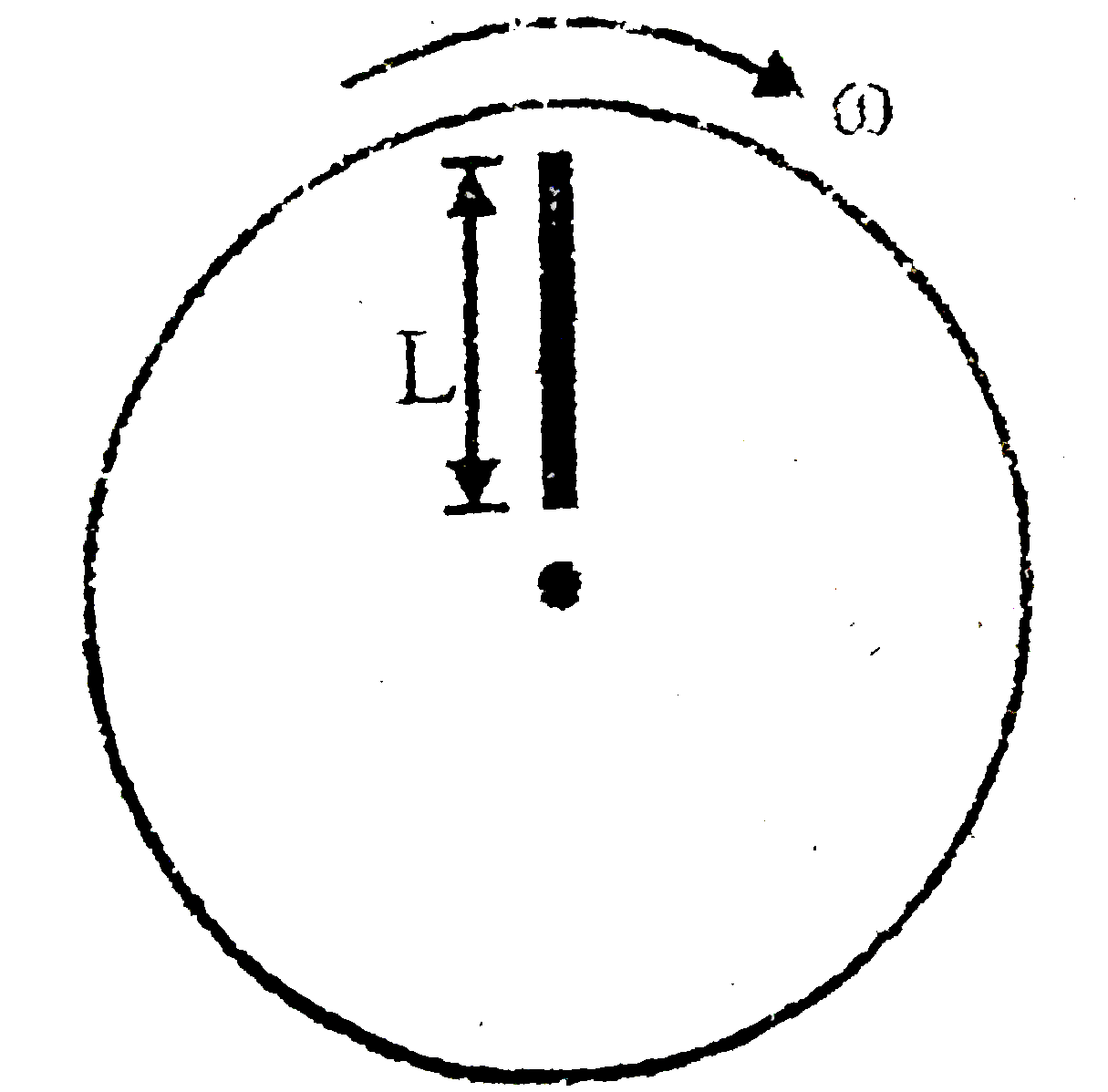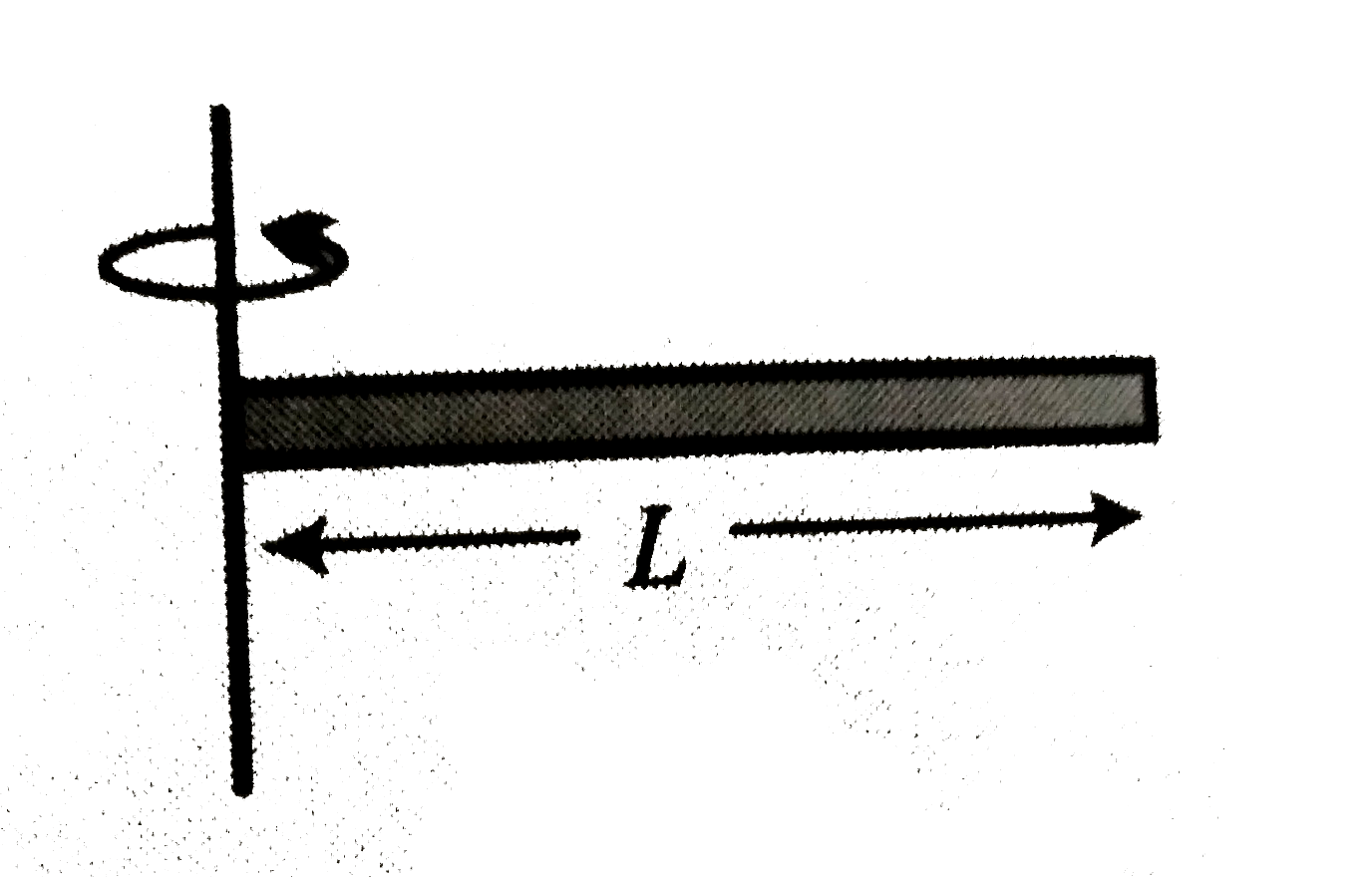A rod of mass m and length L , lying horizontally is free to rotate about a vertical axis through its centre. A horizontal force of constant magnitude F acts on the rod at a distance of L/4 from the centre. The force is always perpendicular to the rod. Find the angle rotated by the rod during the time t after the motion starts.
The correct Answer is:B, C
To solve the problem, we need to determine the angle rotated by the rod during a time t after a constant horizontal force F is applied. Here’s a step-by-step breakdown of the solution:
Step 1: Calculate the Torque
The torque τ acting on the rod due to the force F can be calculated using the formula:
τ=F⋅d
where d is the distance from the axis of rotation to the point where the force is applied. In this case, d=L4. Therefore, the torque is:
τ=F⋅L4
Step 2: Calculate the Moment of Inertia
The moment of inertia I of a uniform rod about its center is given by:
I=112mL2
Step 3: Relate Torque to Angular Acceleration
Using the relation between torque and angular acceleration α:
τ=Iα
Substituting the values we have:
F⋅L4=112mL2⋅α
Step 4: Solve for Angular Acceleration
Rearranging the equation to solve for α:
α=F⋅L4112mL2
This simplifies to:
α=F⋅3mL
Step 5: Use Angular Kinematics to Find the Angle Rotated
Since the initial angular velocity ω0=0 (the rod starts from rest), we can use the angular displacement formula:
θ=ω0t+12αt2
Substituting ω0=0:
θ=12αt2
Now substituting the value of α:
θ=12(3FmL)t2
This simplifies to:
θ=3Ft22mL
Final Result
Thus, the angle rotated by the rod during the time t is:
θ=3Ft22mL
The torque τ acting on the rod due to the force F can be calculated using the formula:
τ=F⋅d
where d is the distance from the axis of rotation to the point where the force is applied. In this case, d=L4. Therefore, the torque is:
τ=F⋅L4
The moment of inertia I of a uniform rod about its center is given by:
I=112mL2
Using the relation between torque and angular acceleration α:
τ=Iα
Substituting the values we have:
F⋅L4=112mL2⋅α
Rearranging the equation to solve for α:
α=F⋅L4112mL2
This simplifies to:
α=F⋅3mL
Since the initial angular velocity ω0=0 (the rod starts from rest), we can use the angular displacement formula:
θ=ω0t+12αt2
Substituting ω0=0:
θ=12αt2
Now substituting the value of α:
θ=12(3FmL)t2
This simplifies to:
θ=3Ft22mL
Thus, the angle rotated by the rod during the time t is:
θ=3Ft22mL
Topper's Solved these Questions
- ROTATIONAL MECHANICSBOOK - HC VERMA ENGLISHCHAPTER - ROTATIONAL MECHANICSEXERCISE - Questions for short Answer
21 Videos
- ROTATIONAL MECHANICSBOOK - HC VERMA ENGLISHCHAPTER - ROTATIONAL MECHANICSEXERCISE - Objective -2
14 Videos
- REST AND MOTION : KINEMATICSBOOK - HC VERMA ENGLISHCHAPTER - REST AND MOTION : KINEMATICSEXERCISE - Question for short Answer
13 Videos
- SIMPLE HARMONIC MOTIONBOOK - HC VERMA ENGLISHCHAPTER - SIMPLE HARMONIC MOTIONEXERCISE - Question for short Answer
15 Videos
Similar Questions
A uniform rod of mass m and length l rotates in a horizontal plane with an angular velocity ω about a vertical axis passing through one end. The tension in the rod at a distance x from the axis is
View SolutionA thin uniform rod AB of mass m and length L is placed on a smooth horizontal table. A constant horizontal force of magnitude F starts acting on the rod at one of the ends AB, Initially, the force is perpendicular to the length of the rod. Taking the moment at which force starts acting as t=0, find.
(a) Distance moved by centre of mass of the rod in time t0.
(b) Magnitude of initial acceleration of the end A of the rod.
View SolutionA rod is of mass M = 3kg and length 2a (a = 2m). Find moment of inertia about an axis through the centre of the rod and perpendicular to the rod. (b) parallel to the rod and distant d = 2m from it?
View SolutionA uniform rod of mass m and length L lies radialy on a disc rotating with angular speed ω in a horizontal plane about vertical axis passing thorugh centre of disc. The rod does not slip on the disc and the centre of the rod is at a distance 2L from the centre of the disc. them the kinetic energy of the rod is

View SolutionA uniform rod of mass m, length l rests on a smooth horizontal surface. Rod is given a sharp horizontal impulse p perpendicular to the rod at a distance l/4 from the centre. The angular velocity of the rod will be
View SolutionA thin horizontal uniform rod AB of mass m and length l can rotate freely about a vertical axis passing through its end A. At a certain moment, the end B starts experiencing a constant force F which is always perpendicular to the original position of the stationary rod and directed in a horizontal plane. The angular velocity of the rod as a function of its rotation angle θ measured relative to the initial position should be.
View SolutionA uniform rod of mass M and length L, which is free to rotate about a fixed vertical axis through O, is lying on a frictionless horizontal table. A particle of equal mass strikes the rod with a velocity V0 and sticks to it. The angular velocity of the combination immediately after the collision is:
View SolutionA straight rod AB of mass M and length L is placed on a frictionless horizontal surface. A force having constant magnitude F and a fixed direction start acting at the end A. The rod is initially perpendicular to the force. The initial acceleration of end B is
View SolutionA uniform of mass m and length L is tied to a vertical shaft. It rotates in horizontal plane about the vertical axis at angular velocity ω. How much horizontal force does the shaft exert on the rod?

View SolutionA uniform rod of mass m and length L is free to rotate in the vertical plane about a horizontal axis passing through its end. The rod initially in horizontal position is released. The initial angular acceleration of the rod is:

View Solution
